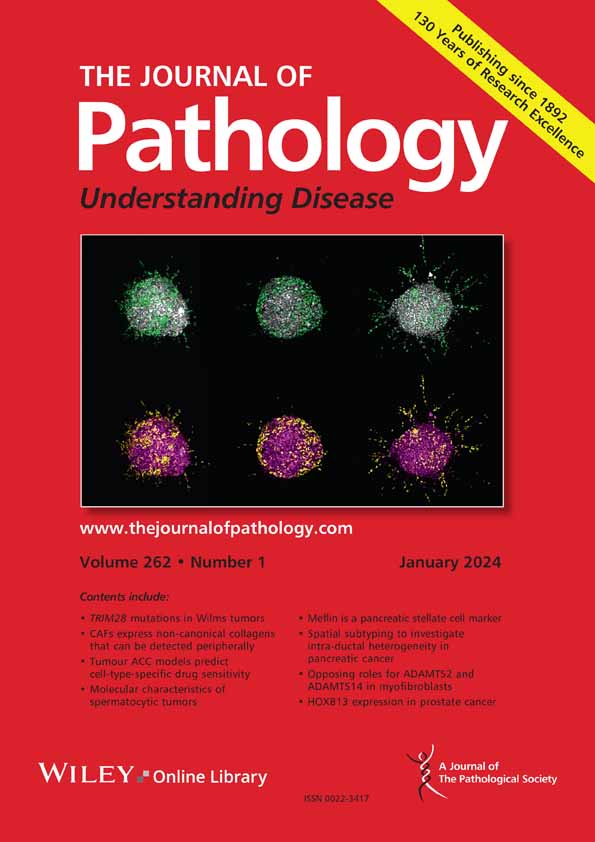Sara Vázquez-Sánchez, Ana Blasco, Pablo Fernández-Corredoira, Paula Cantolla, Elisa Mercado-García, Elena Rodríguez-Sánchez, Laura González-Lafuente, Jonay Poveda, Daniel González-Moreno, Andrea Matutano, Sonia Peribañez, Inés García-Consuegra, Massimo Volpe, María Fernández-Velasco, Luis M. Ruilope, Gema Ruiz-Hurtado
下载PDF
{"title":"心肌梗死后重组Klotho通过阻断细胞内钙处理不当和CaMKII激活减少缺血损伤和心律失常。","authors":"Sara Vázquez-Sánchez, Ana Blasco, Pablo Fernández-Corredoira, Paula Cantolla, Elisa Mercado-García, Elena Rodríguez-Sánchez, Laura González-Lafuente, Jonay Poveda, Daniel González-Moreno, Andrea Matutano, Sonia Peribañez, Inés García-Consuegra, Massimo Volpe, María Fernández-Velasco, Luis M. Ruilope, Gema Ruiz-Hurtado","doi":"10.1002/path.6388","DOIUrl":null,"url":null,"abstract":"<p>Ischaemic heart disease (IHD) remains a major cause of death and morbidity. Klotho is a well-known anti-ageing factor with relevant cardioprotective actions, at least when renal dysfunction is present, but its actions are much less known when renal function is preserved. This study investigated Klotho as a biomarker and potential novel treatment of IHD-associated complications after myocardial infarction (MI) under preserved renal function. Association between circulating Klotho levels and cardiac injury was investigated in patients after ST-elevation MI (STEMI). Biochemical, <i>in vivo</i> and <i>in vitro</i> cardiac function and histological and molecular studies were performed to determine the effect of recombinant Klotho in the failing hearts of mice after MI. We demonstrated that STEMI patients showed lower systemic Klotho levels, with the lowest Klotho tertile in those patients with higher N-terminal pro B-type natriuretic peptide (NT-proBNP) levels. Mice also showed a decrease in systemic Klotho levels after MI induction. Furthermore, recombinant Klotho administration in mice reduced infarct area and attenuated cardiac hypertrophy and fibrosis. We also demonstrated that Klotho treatment prevented reduction in ejection fraction and MI-related ECG changes, including prolonged QRS, JT, QTc, and T<sub>peak</sub>T<sub>end</sub> intervals and premature ventricular contractions. In adult mouse cardiomyocytes, Klotho treatment restricted systolic calcium (Ca<sup>2+</sup>) release and cell shortening disturbances after MI. Klotho prevented increased diastolic Ca<sup>2+</sup> leak and pro-arrhythmogenic events in PMI mice by blocking activation of the Ca<sup>2+</sup>/calmodulin-dependent kinase type II (CaMKII) pathway, preventing ryanodine receptor type 2 (RyR<sub>2</sub>) hyperphosphorylation. In conclusion, Klotho supplementation protected against functional and structural cardiac remodelling and ameliorated ventricular arrhythmic events by preventing intracardiomyocyte Ca<sup>2+</sup> mishandling in mice following MI. These data uncover a new cardioprotective role of Klotho, emerging as a biomarker of ventricular injury and potential treatment for patients after MI. © 2025 The Author(s). <i>The Journal of Pathology</i> published by John Wiley & Sons Ltd on behalf of The Pathological Society of Great Britain and Ireland.</p>","PeriodicalId":232,"journal":{"name":"The Journal of Pathology","volume":"265 3","pages":"342-356"},"PeriodicalIF":5.2000,"publicationDate":"2025-01-15","publicationTypes":"Journal Article","fieldsOfStudy":null,"isOpenAccess":false,"openAccessPdf":"https://onlinelibrary.wiley.com/doi/epdf/10.1002/path.6388","citationCount":"0","resultStr":"{\"title\":\"Recombinant Klotho administration after myocardial infarction reduces ischaemic injury and arrhythmias by blocking intracellular calcium mishandling and CaMKII activation\",\"authors\":\"Sara Vázquez-Sánchez, Ana Blasco, Pablo Fernández-Corredoira, Paula Cantolla, Elisa Mercado-García, Elena Rodríguez-Sánchez, Laura González-Lafuente, Jonay Poveda, Daniel González-Moreno, Andrea Matutano, Sonia Peribañez, Inés García-Consuegra, Massimo Volpe, María Fernández-Velasco, Luis M. Ruilope, Gema Ruiz-Hurtado\",\"doi\":\"10.1002/path.6388\",\"DOIUrl\":null,\"url\":null,\"abstract\":\"<p>Ischaemic heart disease (IHD) remains a major cause of death and morbidity. Klotho is a well-known anti-ageing factor with relevant cardioprotective actions, at least when renal dysfunction is present, but its actions are much less known when renal function is preserved. This study investigated Klotho as a biomarker and potential novel treatment of IHD-associated complications after myocardial infarction (MI) under preserved renal function. Association between circulating Klotho levels and cardiac injury was investigated in patients after ST-elevation MI (STEMI). Biochemical, <i>in vivo</i> and <i>in vitro</i> cardiac function and histological and molecular studies were performed to determine the effect of recombinant Klotho in the failing hearts of mice after MI. We demonstrated that STEMI patients showed lower systemic Klotho levels, with the lowest Klotho tertile in those patients with higher N-terminal pro B-type natriuretic peptide (NT-proBNP) levels. Mice also showed a decrease in systemic Klotho levels after MI induction. Furthermore, recombinant Klotho administration in mice reduced infarct area and attenuated cardiac hypertrophy and fibrosis. We also demonstrated that Klotho treatment prevented reduction in ejection fraction and MI-related ECG changes, including prolonged QRS, JT, QTc, and T<sub>peak</sub>T<sub>end</sub> intervals and premature ventricular contractions. In adult mouse cardiomyocytes, Klotho treatment restricted systolic calcium (Ca<sup>2+</sup>) release and cell shortening disturbances after MI. Klotho prevented increased diastolic Ca<sup>2+</sup> leak and pro-arrhythmogenic events in PMI mice by blocking activation of the Ca<sup>2+</sup>/calmodulin-dependent kinase type II (CaMKII) pathway, preventing ryanodine receptor type 2 (RyR<sub>2</sub>) hyperphosphorylation. In conclusion, Klotho supplementation protected against functional and structural cardiac remodelling and ameliorated ventricular arrhythmic events by preventing intracardiomyocyte Ca<sup>2+</sup> mishandling in mice following MI. These data uncover a new cardioprotective role of Klotho, emerging as a biomarker of ventricular injury and potential treatment for patients after MI. © 2025 The Author(s). <i>The Journal of Pathology</i> published by John Wiley & Sons Ltd on behalf of The Pathological Society of Great Britain and Ireland.</p>\",\"PeriodicalId\":232,\"journal\":{\"name\":\"The Journal of Pathology\",\"volume\":\"265 3\",\"pages\":\"342-356\"},\"PeriodicalIF\":5.2000,\"publicationDate\":\"2025-01-15\",\"publicationTypes\":\"Journal Article\",\"fieldsOfStudy\":null,\"isOpenAccess\":false,\"openAccessPdf\":\"https://onlinelibrary.wiley.com/doi/epdf/10.1002/path.6388\",\"citationCount\":\"0\",\"resultStr\":null,\"platform\":\"Semanticscholar\",\"paperid\":null,\"PeriodicalName\":\"The Journal of Pathology\",\"FirstCategoryId\":\"3\",\"ListUrlMain\":\"https://pathsocjournals.onlinelibrary.wiley.com/doi/10.1002/path.6388\",\"RegionNum\":2,\"RegionCategory\":\"医学\",\"ArticlePicture\":[],\"TitleCN\":null,\"AbstractTextCN\":null,\"PMCID\":null,\"EPubDate\":\"\",\"PubModel\":\"\",\"JCR\":\"Q1\",\"JCRName\":\"ONCOLOGY\",\"Score\":null,\"Total\":0}","platform":"Semanticscholar","paperid":null,"PeriodicalName":"The Journal of Pathology","FirstCategoryId":"3","ListUrlMain":"https://pathsocjournals.onlinelibrary.wiley.com/doi/10.1002/path.6388","RegionNum":2,"RegionCategory":"医学","ArticlePicture":[],"TitleCN":null,"AbstractTextCN":null,"PMCID":null,"EPubDate":"","PubModel":"","JCR":"Q1","JCRName":"ONCOLOGY","Score":null,"Total":0}
引用次数: 0
引用
批量引用






 求助内容:
求助内容: 应助结果提醒方式:
应助结果提醒方式:


